Harman Consumer ONAIRWI2LO Wireless Speaker with iPhone Dock User Manual
Harman Consumer, Inc. Wireless Speaker with iPhone Dock
user manual
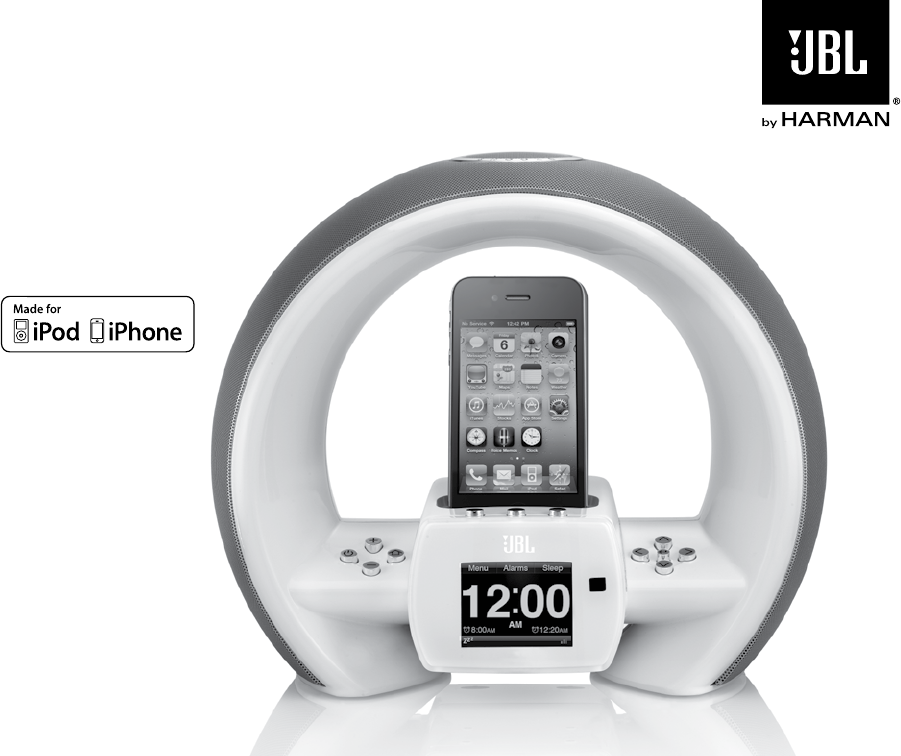
Owner’s Manual
JBl® On air wireless
speaker with iPod/iPhone dock

2
TaBle Of COnTenTs
Introduction 2
Connections 3
Controls and Display 4
Setup Wizard 6
Using Your JBL® On Air Wireless 8
Troubleshooting Your JBL On Air Wireless 16
Appendix: Manual Network Setup 17
Specifications 19
inTrOduCTiOn
The JBL On Air Wireless speaker with iPod/iPhone dock will
revolutionize the way you listen to music. Imagine being able to play
all the iTunes music files in your computer anywhere within range of
your wireless network via AirPlay, waking up to music on your favorite
Internet FM radio station (or to your favorite song from your iPod/
iPhone), with no more buzzers or bad radio reception. When connected
to your iPod/iPhone device, MP3 player or other music source, the
JBL On Air Wireless produces clean, powerful sound while providing
time-keeping, alarm and radio features. And the multiple-alarm option
lets you set different alarms for “his” and “hers” at whatever day or
frequency you need.
IMPORTANT NOTE FOR ALL ELECTRONIC PRODUCTS: Turn off the unit before
inserting or unplugging audio cables from a source device’s headphones or line-level output
jacks. Doing so will prolong the life of your unit, help protect your device from static electricity
and prevent potential damage.
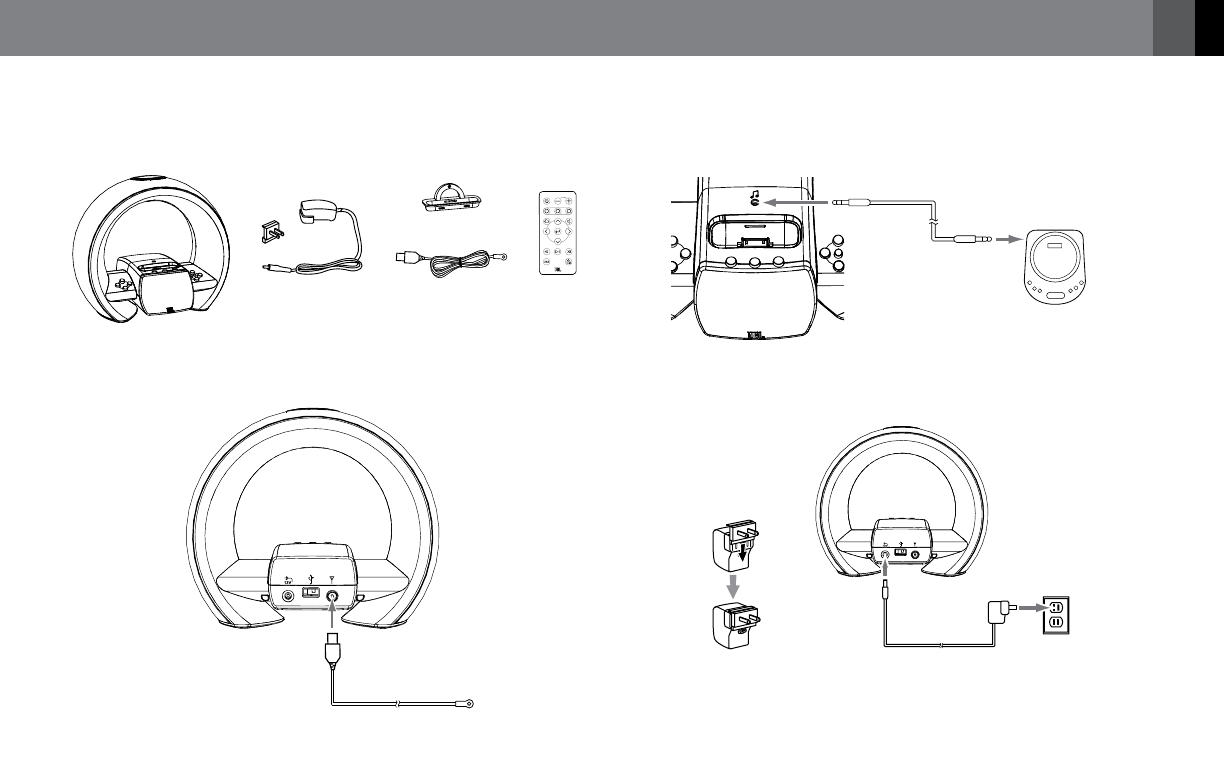
3www.jbl.com
English
COnneCTiOns
1. Carefully unpack your JBL On Air Wireless and confirm that all the
items shown here are included:
iPod Adapter
JBL On Air Wireless
Remote Control
and Battery
FM AntennaPower Supply and Outlet Adapter
(*Adapter varies by region)
*
2. Connect the included FM antenna to the JBL On Air Wireless’s FM
Antenna connector.
FM Antenna (included)
3. If you are going to use your JBL On Air Wireless with another audio
source, plug one end of a 3.5mm stereo cable (not included) into the
JBL On Air Wireless’s Aux Input connector, and plug the other end
into the audio source’s headphone-out or line-out connector.
3.5mm Stereo Cable
(not included)
To Headphone
or Line Output
Portable Music Player
or Other Audio Device
4. Slide the supplied power outlet adapter all the way into the JBL On Air
Wireless’s power supply, plug the power supply into the JBL On Air
Wireless’s 12V connection, and plug the power supply into a wall outlet.
Power Supply
(included)
1. 2.
IMPORTANT: Use the JBL On Air Wireless’s USB port only to perform
system updates. Do NOT connect it to a computer or any other type of
USB host/controller. You could damage the JBL On Air Wireless or the
host/controller device. See System Update, on page 14.
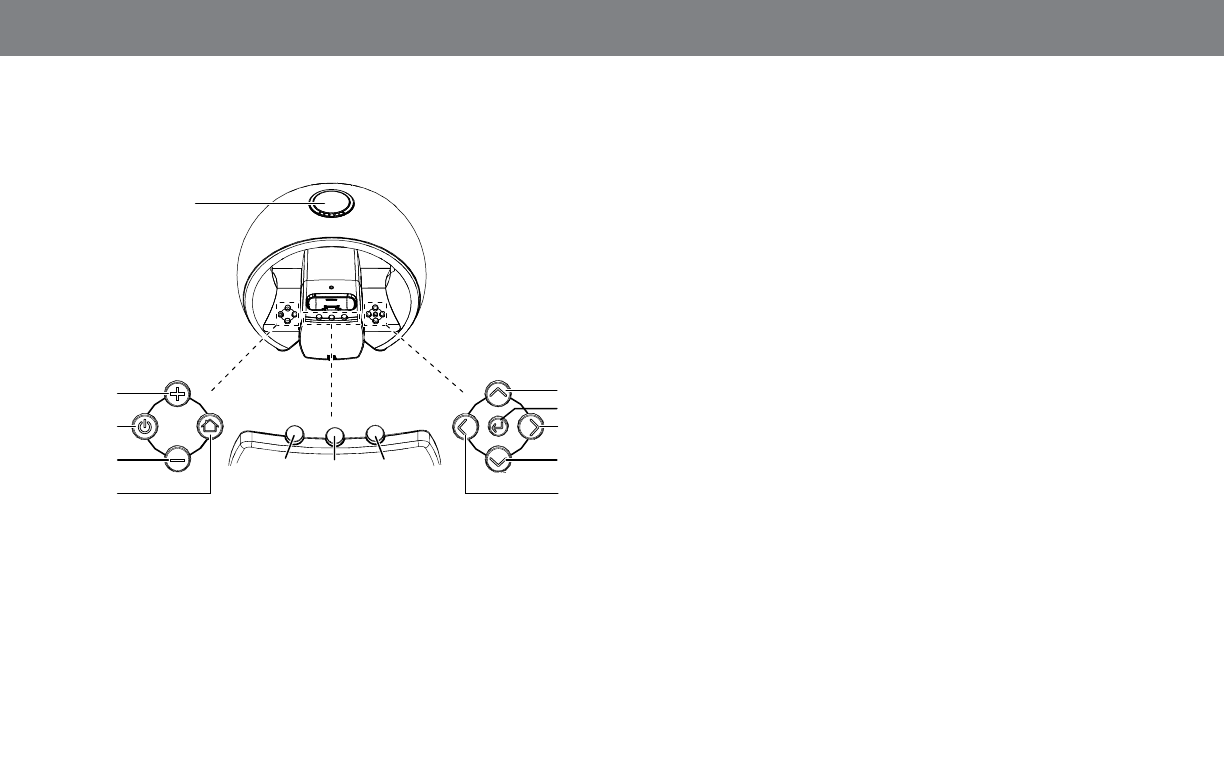
4
COnTrOls and display
CONTROLS
Snooze/
Alarm Off
Volume
Up Up
OK
Right
Down
Left
Left
Soft
Button
Center
Soft
Button
Right
Soft
Button
Volume
Down
Home
Power
• Snooze/Alarm Off button: Press this button momentarily to shut
the alarm sound off for nine minutes. The alarm will then sound again.
Press and hold this button for three seconds to shut off the alarm
sound until the next time the alarm is scheduled to ring.
• Power button: Press this button to turn the JBL On Air Wireless
on or to put it into the Standby mode. (NOTE: The alarms will still
function when the JBL On Air Wireless is in the Standby mode.)
• Volume Up/Down buttons: Press these buttons to raise or lower the
volume. Press both buttons simultaneously to mute the sound. When
the sound is muted, press either the Volume Up or the Volume Down
button to restore the sound. (NOTE: On the remote control, the mute
function has its own button. See Remote Control Buttons, on page 5.)
• Home button: Press this button to display the Home/Clock screen
(see Main Display, on page 6). If you press the button when the
Home/Clock screen is displayed, the JBL On Air Wireless will display
the Main Menu screen. See Listening to a Source, on page 8.
• Left/Center/Right Soft buttons: The functions of these buttons
will vary according to the screen that is active when the buttons are
pushed. See Using Your JBL On Air Wireless, on page 8, for more
information.
• Up/Down buttons: Press these buttons to scroll up or down the
menu screens and to highlight items.
• OK button: On most menu screens, press this button to select a
highlighted menu item. See Using Your JBL On Air Wireless, on
page 8, for more information.
• Left and Right buttons: Press the Left button to return to the
previous menu screen. The function of the Right button depends on
the screen that is active when you press the button. On many menu
screens, pressing the Right button performs the same function as
pressing the OK button. See Using Your JBL On Air Wireless, on
page 8, for more information.
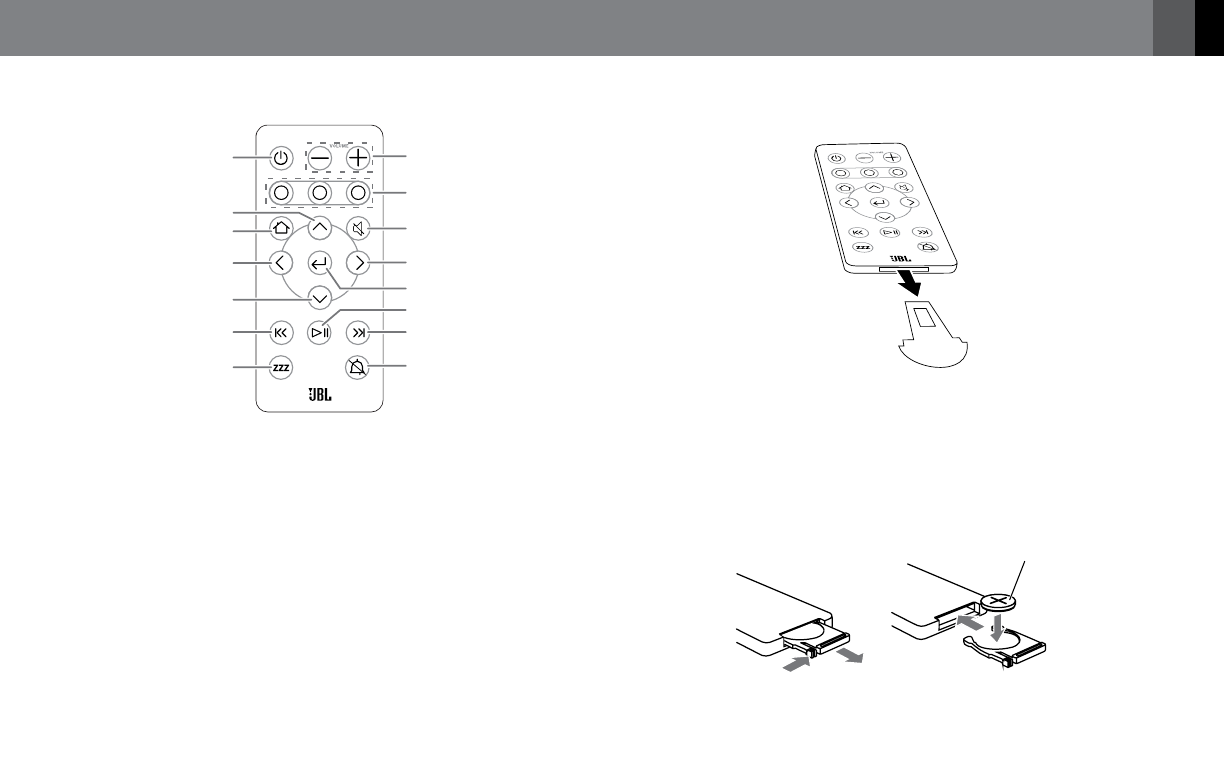
5www.jbl.com
English
REMOTE CONTROL BUTTONS
Volume Up/DownPower
Up
Home
Left
Down
Previous
Snooze
Soft Buttons
Mute
Right
OK
Play/Pause
Next
Alarm Off
• Previous, Play/Pause and Next buttons: When listening to AirPlay
or an iPod device, press these buttons to skip to the previous song,
play/pause the current song, or skip to the next song.
• Mute button: Press this button to mute the sound; press it again to
restore the sound.
• Alarm Off button: Press this button to shut off the alarm sound until
the next time the alarm is scheduled to ring.
The remaining remote control buttons perform the same functions as
their counterparts on the JBL On Air Wireless unit.
Before using the remote control, remove the battery contact-protection
strip by pulling on the tab.
Changing the remote control’s battery:
1. Press the tab on the side of the battery tray and pull the tray out of
the remote.
2. Place a model CR2025 battery into the tray with the positive (+)
terminal facing as shown in the illustration, and replace the battery
tray in the remote.
CR2025
Battery
1. 2.
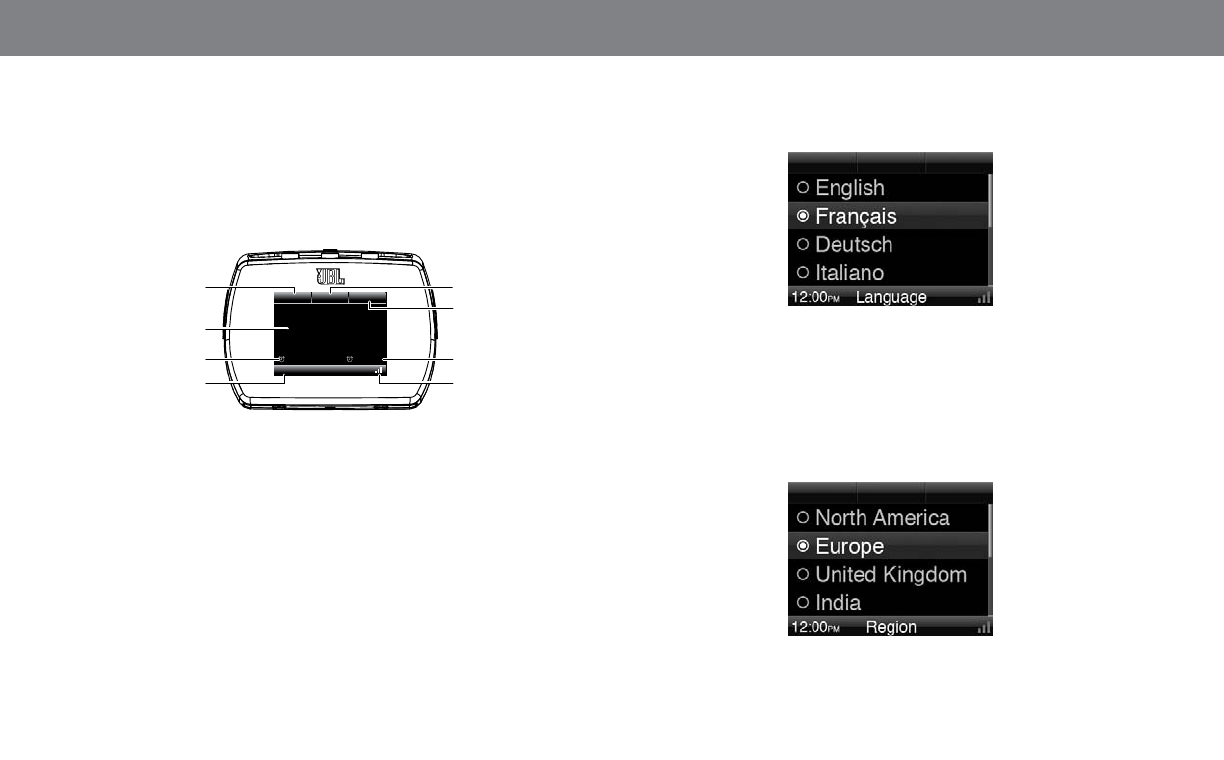
6
MAIN DISPLAY
NOTE: The display screens shown throughout this manual are for
illustrative purposes and may differ somewhat from the actual display
screens.
The Home/Clock screen is the JBL On Air Wireless’s main screen and is
the base for all navigation.
12:00
AM
Menu
6:50
AM
Z
Z
Z
7:15
AM
Alarms
Sleep
Right Soft-Button Function
Alarm 2 Time
Wi-Fi® Signal Strength
Center Soft-Button FunctionLeft Soft-Button Function
Alarm 1 Time
Snooze On/Off Indicator
Current Time
Other menu screens are shown in the Setup Wizard section (this page),
and the Using Your JBL On Air Wireless section (page 8).
seTup wizard
When you turn your JBL On Air Wireless on for the first time, the Setup
Wizard requires that you set the language, region, time zone, time, day
and network before you can play music or use the clock functions.
To return to the previous menu screen at any time, press the Left
button.
LANGUAGE
1. Use the Up and Down buttons to highlight the your choice of
language for the JBL On Air Wireless’s display.
2. Press the OK button to select your choice. The display will immediately
change to the selected language, and the Region screen will appear.
REGION
This screen automatically sets the JBL On Air Wireless’s FM-radio
frequency band and tuning increments to match the FM-radio
broadcasts in your region.
1. Use the Up and Down buttons to highlight the region you live in.
2. Press the OK button to select the highlighted region. The Time Zone
screen will appear.
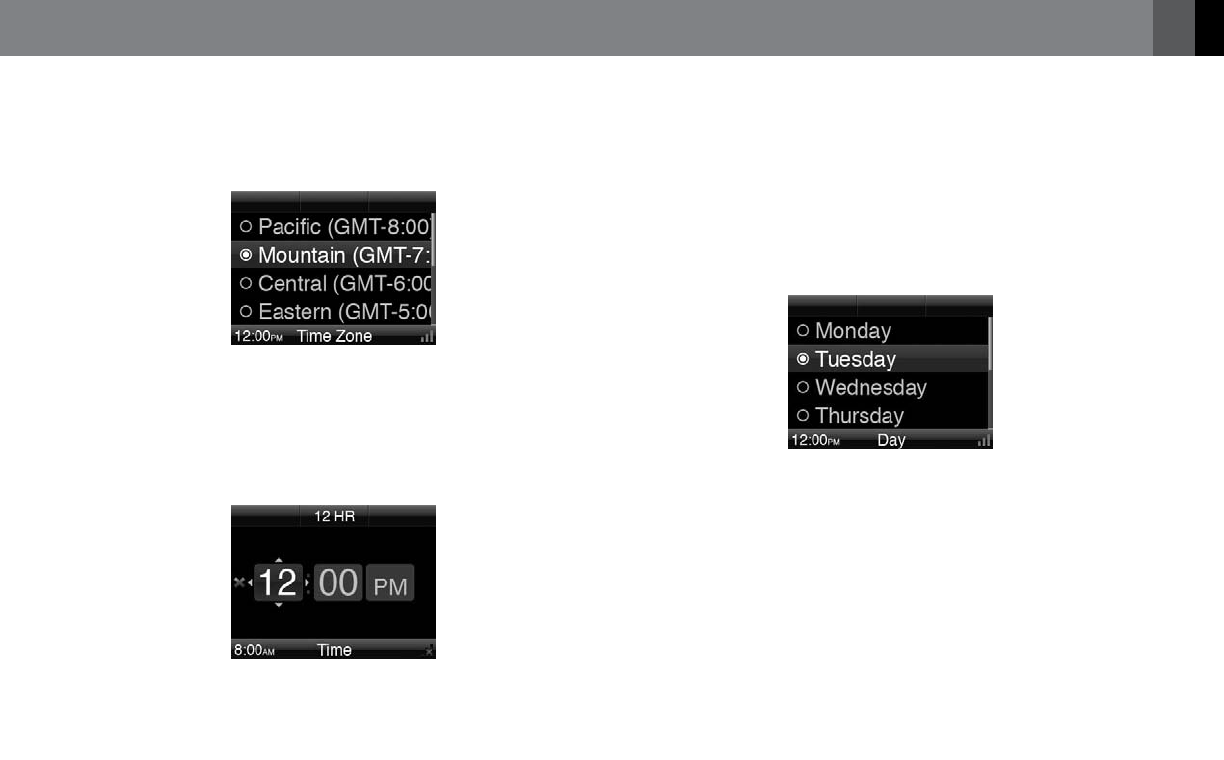
7www.jbl.com
English
TIME ZONE
This screen sets the JBL On Air Wireless’s clock to match the time zone
in your area.
1. Use the Up and Down buttons to highlight the time zone you live in.
2. Press the OK button to select the highlighted time zone. The Time
screen will appear.
TIME
1. Use the Center Soft button to set the clock to the 12-hour or 24-
hour mode. The active mode is displayed directly below the button,
and the hours are highlighted.
2. Use the Up and Down buttons to set the current hour, and press the
OK button. The minutes are highlighted.
3. Use the Up and Down buttons to set the current minute, and press
the OK button.
• If the clock is in the 24-hour mode, the Day screen will appear.
• If the clock is in the 12-hour mode, AM/PM will be highlighted.
Use the Up and Down buttons to set AM or PM, and press the OK
button. The Day screen will appear.
DAY
1. Use the Up and Down buttons to highlight the current day of the week.
2. Press the OK button to select the highlighted day. The Network
screen will appear.
NETWORK
You can connect your JBL On Air Wireless to your Wi-Fi® network.
Connecting to your network will enable your JBL On Air Wireless to play
music files and Internet radio broadcasts that your computer streams to it.
1. When the Network screen appears, the JBL On Air Wireless will
automatically search for any available Wi-Fi networks.
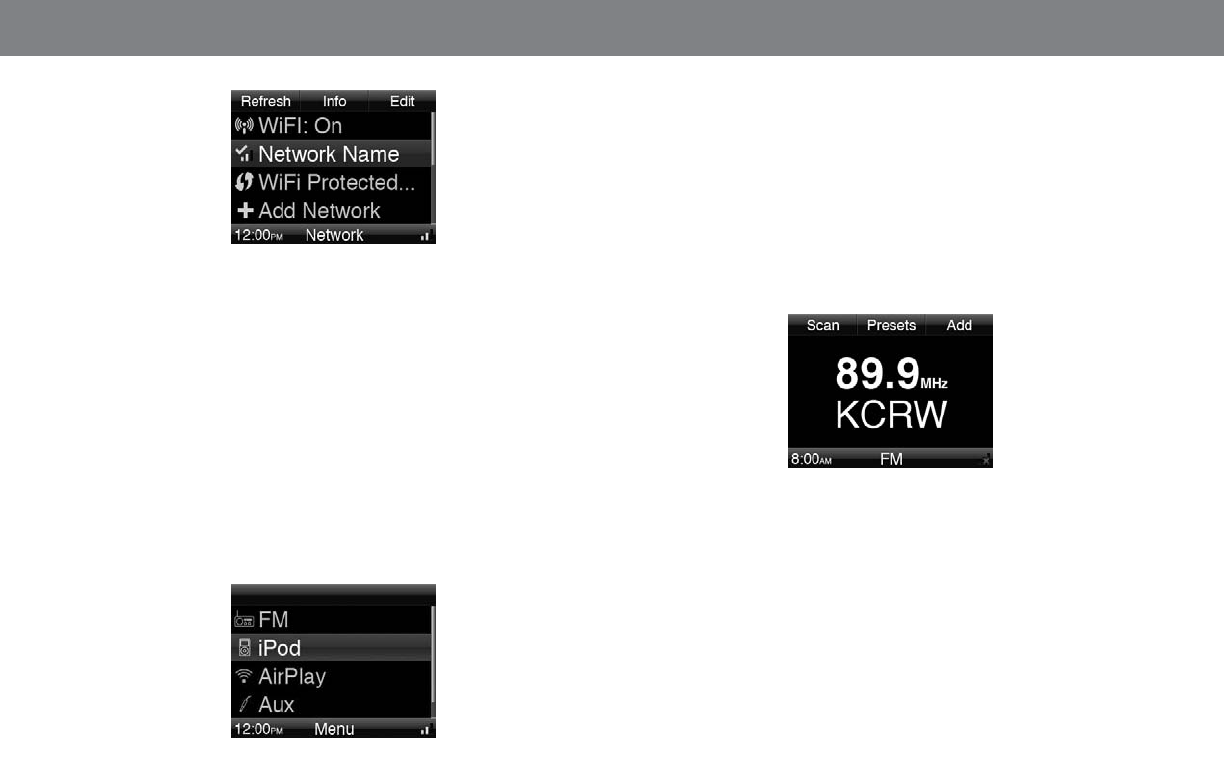
8
2. When the search is completed, the screen will display a list of up to
four available networks.
3. Use the Up and Down buttons to highlight the network you want to
use, and press the OK button to select it.
4. Press the Home button to exit the Setup Wizard. The Home/Clock
screen will appear.
NOTE: If the JBL On Air Wireless cannot connect to your Wi-Fi network,
it will display a “Wi-Fi connection not functioning” message. To connect
to a network manually, see Settings: Network, on page 13.
using yOur JBl On air wireless
LISTENING TO A SOURCE
When the Home/Clock screen is displayed, press the Home button to
display the Main Menu.
The Main Menu lets you scroll through and select the following items:
FM, iPod, AirPlay, Aux and Settings.
Use the Up, Down and OK buttons to highlight and select an item.
NOTE: “AirPlay” will appear in the Main Menu list only if iTunes AirPlay
streaming has already been initiated from a networked computer. See
Listening to Streaming Audio from Your Computer, on page 10, for
more information.
LISTENING TO FM RADIO
Selecting “FM” on the Main Menu displays the FM-radio screen.
NOTE: If the station is broadcasting RDS data, the station’s call letters
will appear below the broadcast frequency.
To tune to the next higher or lower receivable station:
1. Press the Left Soft button to put the radio in the scan mode. The
display will show “Scan” under the button.
2. Press the Up or Down buttons to scan up or down to the next
receivable station.
To tune up or down by one tuning increment:
1. Press the Left Soft button to put the radio in the tune mode. The
display will show “Tune” under the button.
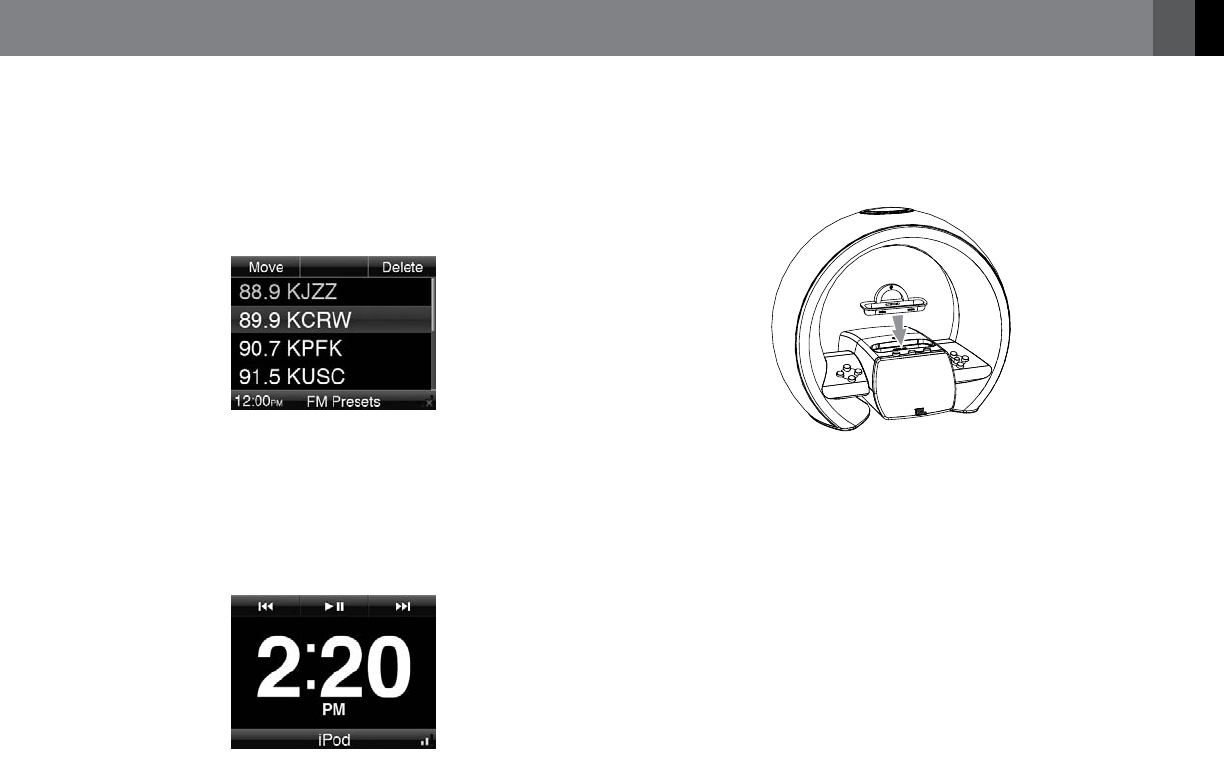
9www.jbl.com
English
2. Press the Up or Down button to tune up or down by one tuning
increment. Hold down the button to tune up or down continually until
you release the button.
To save the currently tuned station as a preset:
Press the Right Soft button. You can store up to 10 stations as presets.
To listen to a preset station:
Press the Center Soft button to display the FM Presets screen.
Use the Up or Down button to scroll through the list and highlight each
station. Press the OK button to listen to a highlighted station.
Deleting a preset station:
Use the Up or Down button to highlight the station. Press the Right Soft
(Delete) button to delete the station.
LISTENING TO YOUR iPod/iPhone DEVICE
Selecting “iPod” on the Main Menu displays the iPod playback screen.
NOTE: Be sure to install the supplied adapter into the JBL On Air
Wireless before docking your iPod/iPhone device (see illustration). Do
not place an iPod or iPhone device in the JBL On Air Wireless unless
the dock adapter is installed. Otherwise, the iPod or iPhone device
will not connect properly, and both it and the JBL On Air Wireless may
sustain damage that is not covered by the warranty.
Use the JBL On Air Wireless’s Soft buttons (or the remote control) to
control playback of your iPod/iPhone device:
• Press the Left Soft (Previous) button to skip back.
• Press the Right Soft (Next) button to skip ahead.
• Press the Center Soft (Play/Pause) button to play/pause.
The JBL On Air Wireless will charge your iPod/iPhone device while it is
docked.
NOTE: We recommend that you pause playback before undocking your
iPod or iPhone device from the JBL On Air Wireless.
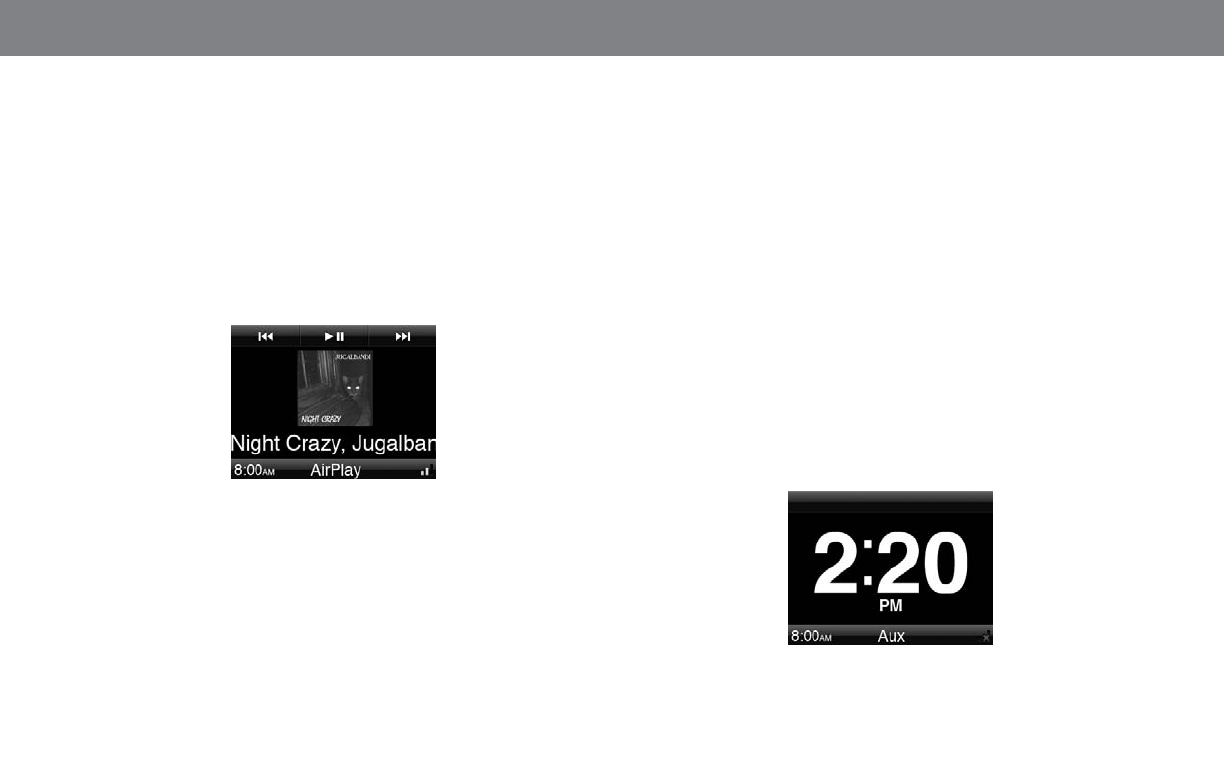
10
LISTENING TO STREAMING AUDIO FROM YOUR COMPUTER
Selecting “AirPlay” on the JBL On Air Wireless’s Main Menu lets you
play audio files or an Internet radio station that is streaming from a
networked computer.
NOTE: The computer must have the Apple iTunes application installed.
To download the application, go to www.apple.com/iTunes.
You must initiate the AirPlay streaming operation from the networked
computer before selecting “AirPlay” in the JBL On Air Wireless’s Main
Menu. Once streaming has been established, selecting “AirPlay” in the
Main Menu plays the streaming audio and displays the AirPlay screen.
While the JBL On Air Wireless is playing an audio file or Internet radio
station, the display will show any embedded art (if available) and will
scroll song title, artist’s name and album title ID3 data, or will scroll
data embedded by the Internet radio station. If the data is unavailable,
the display will show the song’s file name or the Internet radio station’s
name.
Use the JBL On Air Wireless’s Soft buttons (or the remote control) for
basic playback control of the streaming audio file:
• Press the Left Soft (Previous) button to skip back.
• Press the Right Soft (Next) button to skip ahead.
• Press the Center Soft (Play/Pause) button to play/pause.
The JBL On Air Wireless may display error messages that the computer
passes to it while streaming content to it.
Switching to any of the JBL On Air Wireless’s other audio sources will
break the streaming signal from the computer. You must re-establish
the streaming signal from the computer before switching the JBL On Air
Wireless back to the AirPlay source.
For complete information about streaming audio files and Internet
radio stations, consult the documentation for your computer’s iTunes
software application.
LISTENING TO AN AUXILIARY AUDIO SOURCE
Selecting “Aux” on the Main Menu plays audio from a source connected
to the JBL On Air Wireless’s Aux Input connector. The JBL On Air
Wireless will display the Aux playback screen.
Use the JBL On Air Wireless’s Volume Up/Down buttons to change the
volume. The audio source connected to the JBL On Air Wireless’s Aux
input controls the playback.
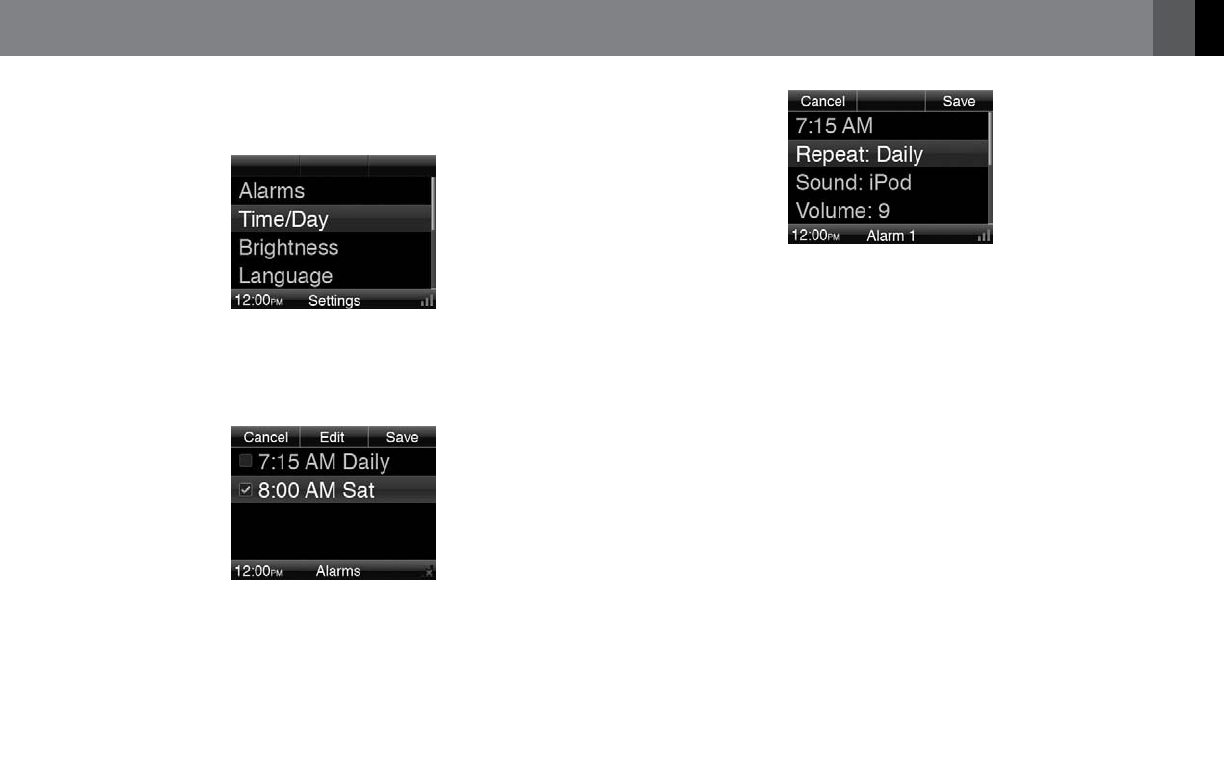
11www.jbl.com
English
SETTINGS
Selecting “Settings” on the Main Menu screen displays the Settings
Menu screen:
This screen lets you configure your JBL On Air Wireless to operate the
way you want it to.
Alarms
Selecting “Alarms” displays the main Alarms screen:
This screen shows your current alarm settings and lets you change the
alarm settings. Active alarms are indicated by a check mark.
To set an alarm, press the Center Soft (Edit) button. The JBL On Air
Wireless will display the Alarm Settings menu screen. When you’re
finished setting the alarms, press the Right Soft (Save) button to save
the settings.
Use the Up, Down, Left, Right and OK buttons to adjust the following items:
• Alarm Time: Set the time you want the alarm to sound.
• Repeat: Set the alarm to repeat every day, weekdays only or
weekends only, or turn the alarm off.
• Sound: Set the alarm to wake you with a buzzer, FM radio or your
iPod/iPhone device. NOTE: If you select “iPod” and your iPod device
is not docked at the time the alarm is set to ring, the buzzer will
sound.
• Volume: Set how loud you want the alarm to sound.
• Volume Ramp: Selecting “Off” ramps the alarm from silence up to
your pre-determined alarm volume over a period of three seconds.
Selecting “On” ramps the alarm from silence up to your pre-
determined alarm volume over a period of three minutes.
Turning the alarm sound off:
• Press the Snooze button momentarily to shut the alarm sound off.
After nine minutes, the alarm will sound again.
• On the unit, press and hold the Snooze button for three seconds
(on the remote control, press the Alarm Off button) to shut the alarm
sound off until the next time the alarm is scheduled to ring.
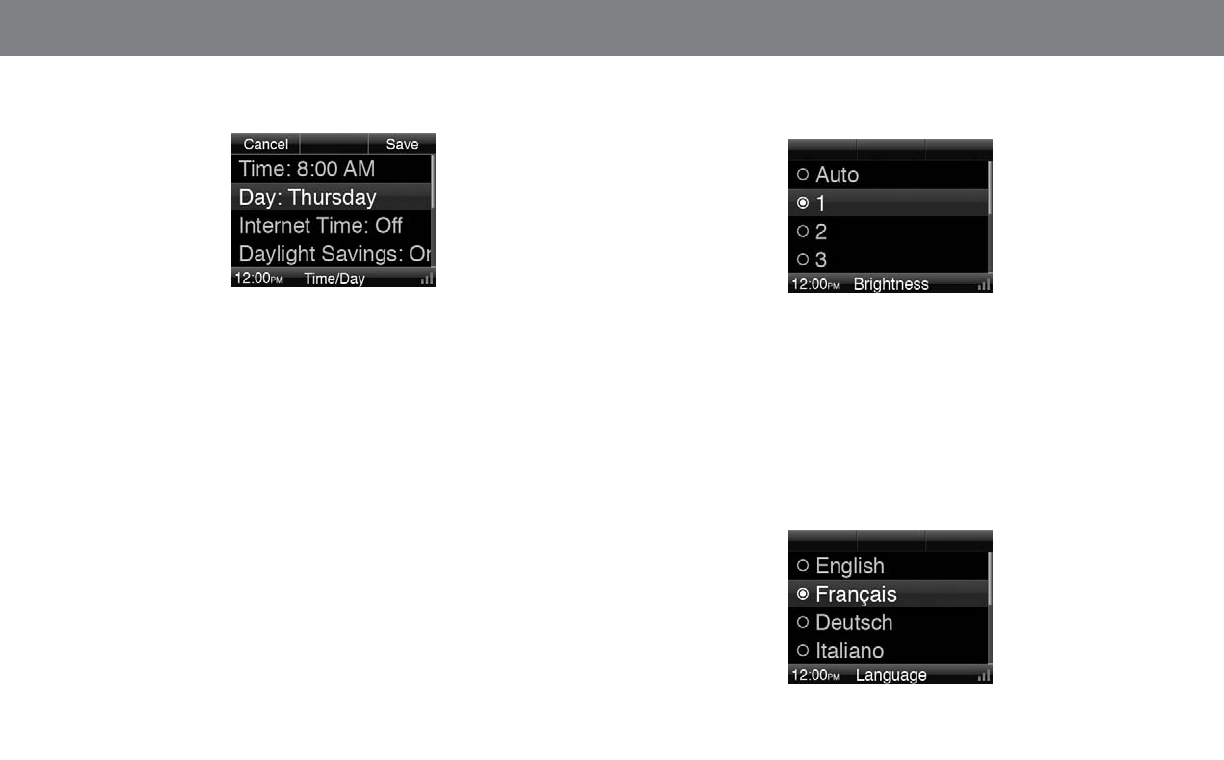
12
Time/Day
Selecting “Time” displays the Main Time menu screen:
Use the Up, Down, Left, Right and OK buttons to adjust the following
items:
• Time: Set the current time of day. You can also set the clock to
operate in the 12-hour or 24-hour mode.
• Day: Set the current day of the week.
• Internet Time: If you select “On,” the JBL On Air Wireless will
automatically set its clock according to an Internet-based time
service. It will automatically maintain the correct time, including an
appropriate Daylight Saving Time offset. If you select “Off,” the clock
will maintain the time settings that you selected using the Main Time
menu screen.
• Daylight Savings Time: Select “On” if Daylight Saving Time is
observed where you live.
• Time Zone: Select your time zone.
When you’re finished making your settings, press the Right Soft (Save)
button to save your settings.
Brightness
Selecting “Brightness” displays the Brightness Setting screen:
Use the Up, Down and OK buttons to highlight and select a display and
button brightness level.
Auto: The JBL On Air Wireless will automatically adjust its display and
button brightness according to the room’s ambient light conditions.
1 – 6: Selecting one of these options manually sets the display and
button brightness to the selected level. The brightness will not vary
according to ambient light conditions.
Language
Selecting “Language” displays the Language Setting screen:
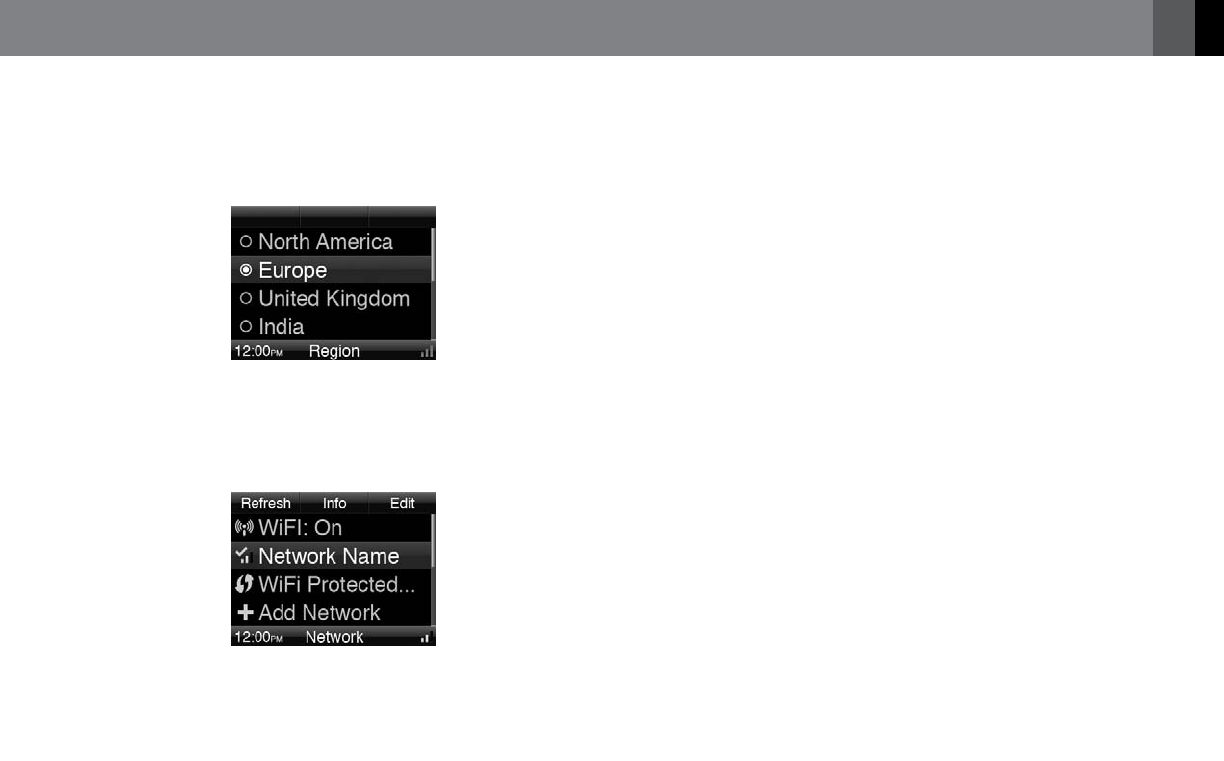
13www.jbl.com
English
Use the Up, Down and OK buttons to select a language for the
JBL On Air Wireless’s display. The JBL On Air Wireless’s interface will
immediately change to the selected language.
Regional Settings
Selecting “Regional Settings” displays the Region screen:
This menu sets the JBL On Air Wireless’s FM radio-frequency band and
tuning increments to match the FM broadcasts in your region. Use the
Up, Down and OK buttons to select the region you live in.
Network
Selecting “Network” displays the Network Setup screen:
This menu provides access to all of the JBL On Air Wireless’s network
settings.
Use the Up and Down buttons to scroll through the list. Use the OK
button to select items, and use the Left button to return to the previous
menu screen.
• Refresh (Left Soft) button: Press this button to search for all
available networks or refresh the list of available networks. The JBL
On Air Wireless will automatically connect to the network that was
used most recently. If that network is unavailable, it will connect to the
next most recently used network and so forth.
• Info (Center Soft) button: Press this button to display the IP
information for the system’s current network settings.
• Edit (Right Soft) button: Press this button to make changes in an
existing network’s setup or to enter information for a new network
manually. See Appendix: Manual Network Setup, on page 17, for
complete instructions.
• Wi-Fi: Select this option to turn the Wi-Fi function on and off.
When you turn the Wi-Fi function on, the JBL On Air Wireless will
automatically search for available Wi-Fi networks.
• [Network Name 1 – 4]: The display screen lists each available
network. The currently-selected network is indicated by a check
mark. The bars indicate the strength of the Wi-Fi network connection.
To select a network, use the Up, Down and OK buttons. If the network
that you select has no security, then the JBL On Air Wireless will
attempt to connect to the network. If the network has saved settings
(e.g., password, IP settings), then the JBL On Air Wireless will attempt
to connect to the network using these settings. If the network requires
a password and the JBL On Air Wireless has not saved a password, it
will display the Settings – Network Password screen so you can enter
the password. See Appendix: Manual Network Setup, on page 17, for
more information.
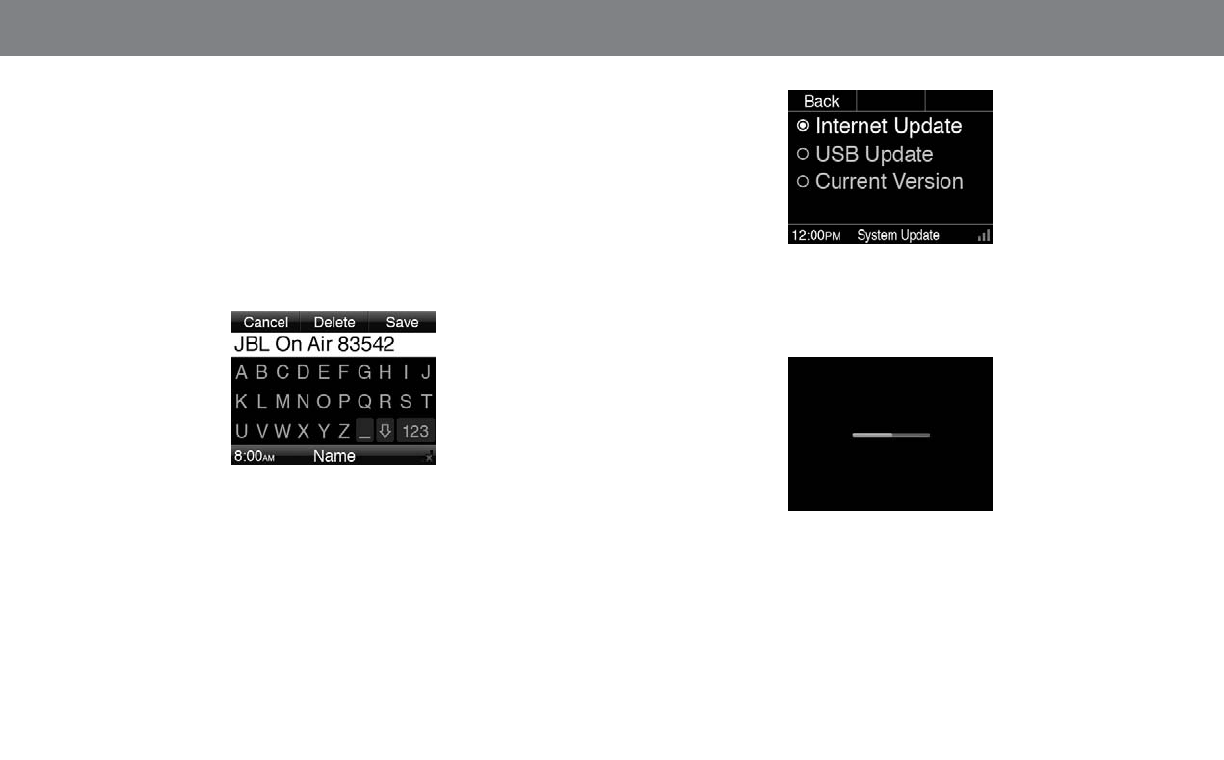
14
• Wi-Fi Protected Setup™ (WPS): If your network router is WPS-
compatible, select this option to set up and configure the JBL On Air
Wireless to work with your network automatically.
• Add Network: Select this option to add a network manually. See
Appendix: Manual Network Setup, on page 17, for more information.
NOTE: If the JBL On Air Wireless is searching for available Wi-Fi networks
when you select Add Network, the search will immediately stop.
• Name [Device]: Select this option to change your JBL On Air
Wireless’s default device name to one of your own choosing. The
Name screen will appear.
Use the Up, Down, Left, Right and OK buttons to select letters on the
keypad to enter the new name. Press the Center Soft (Delete) button to
backspace a character, press the Right Soft (Save) button to save the
new name or use the Left Soft (Back) button to return to the previous
menu screen without changing the device name.
System Update
This menu allows you to update your JBL On Air Wireless’s firmware to
the latest version.
• Internet Update: Select this option to search for and download the
latest firmware from the server. If a new firmware version is available,
the JBL On Air Wireless will automatically download and install it.
During downloading and installation, the JBL On Air Wireless will
display a progress bar.
If the download and installation are successful, the progress bar will turn
green. If the download and installation fail, the progress bar will turn red,
and you will have to repeat the procedure from the System Update screen.
NOTE: The JBL On Air Wireless will automatically attempt to contact
the Internet server once a day in the evening and determine if a new
firmware version is available. If so, it will automaticaly download and
install the new firmware as described above.
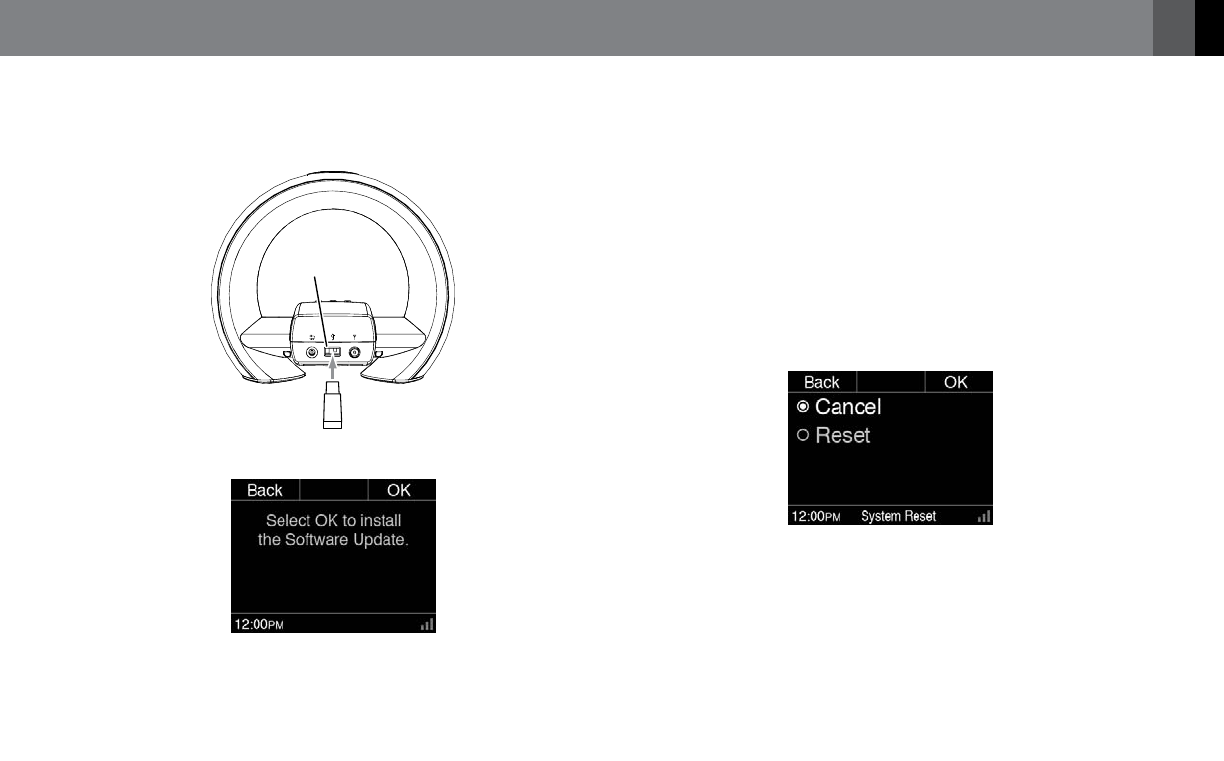
15www.jbl.com
English
• USB Update: You can search for and download new firmware on
your computer and transfer it to a USB memory device. Insert the
USB device into the JBL On Air Wireless’s USB port. Select USB
Update.
USB Memory
Device
USB Port
The JBL On Air Wireless will display the Install Software screen.
Press the Right Soft (OK) button to install the software; press the Left
Soft (Cancel) button to cancel the upgrade and return to the previous
menu screen.
IMPORTANT: Use the JBL On Air Wireless’s USB port only to perform
system updates. Do NOT connect it to a computer or any other type of
USB host/controller. You could damage the JBL On Air Wireless or the
host/controller device.
• Current Version: Select this option to display the version number of
the currently installed firmware. Press the Left Soft (Back) button to
return to the System Update screen.
System Reset
This menu lets you return your JBL On Air Wireless to its out-of-the-box
factory-default condition and erase all of your clock and alarm settings,
network settings, menu settings and FM radio preset stations. When
the JBL On Air Wireless completes the System Reset, it will return to
the Setup Wizard screen (see page 6).
Select Reset or the Right Soft (OK) button to reset the system; select
Cancel or the Left Soft (Back) button to cancel the system reset and
return to the previous menu screen.

16
prOBleM sOluTiOn
No sound (display is not illuminated): • Make sure that the power supply is properly connected to the JBL On Air Wireless
and to a working AC outlet.
No sound (display is illuminated) : • Touch the Volume Up (+) button to increase the system volume.
• If you’re using FM radio, make sure that the included FM antenna is properly
connected and that the JBL On Air Wireless is tuned to an active FM frequency.
• If you’re using a docked iPod/iPhone device, make sure that it is properly docked in
the JBL On Air Wireless.
• If you’re using an auxiliary audio source, make sure that the audio cable is properly
connected to the JBL On Air Wireless’s Aux Input connector and to the source
component’s audio output.
• If you’re using AirPlay, make sure that the computer has initiated streaming before
you select AirPlay as the source in the JBL On Air Wireless’s Main Menu.
• If you’re using AirPlay, make sure that you have selected the correct network in the
JBL On Air Wireless’s Network Setup screen. (See Settings: Network, on page 13.)
• Make sure that the iPod device, AirPlay source or auxiliary source component is not
in the Pause mode and that its volume control is not turned all the way down.
Sound crackles, hisses or is distorted: • Turn the iPod device or other source component’s volume down.
• Make sure that the iPod device’s EQ setting is set to “Off.”
Loud hum or buzzing: • Make sure that the audio cable is plugged all the way into the JBL On Air Wireless’s
Aux Input jack.
• Replace the audio cable.
• Unplug the power supply and connect it to a different AC outlet.
TrOuBleshOOTing yOur JBl On air wireless
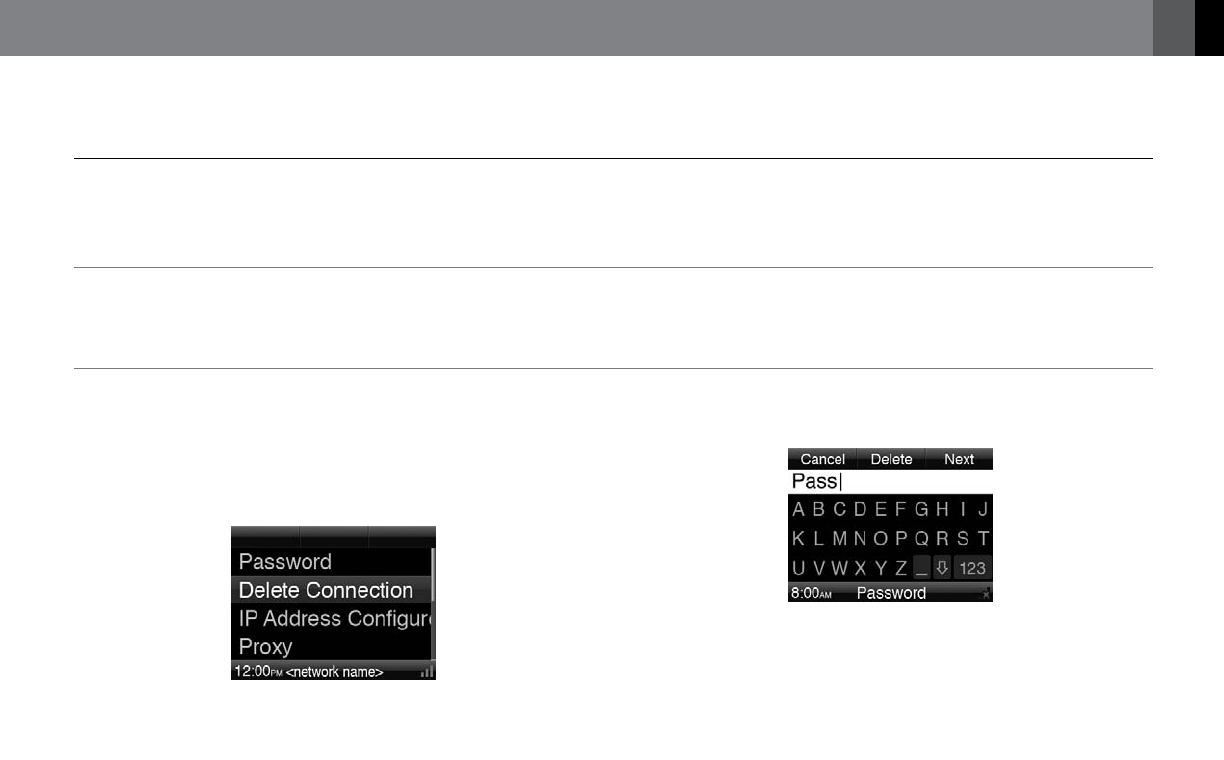
17www.jbl.com
English
prOBleM sOluTiOn
Sound comes from only one speaker: • Make sure that the iPod/iPhone device is properly seated all the way into the docking
connector.
• Make sure that the audio cable is plugged all the way into the Aux Input jack.
• Make sure that the audio cable is a stereo cable.
The JBL On Air Wireless does not respond to any
button presses:
• Press and hold the Snooze and Power buttons on the unit together for seven
seconds to reset the unit’s microprocessor. NOTE: Resetting the microprocessor will
erase all of your clock and alarm settings, network settings, menu settings and FM-
radio preset stations. When the microprocessor reset is completed, the JBL On Air
Wireless will return to the Setup Wizard screen (see on page 6).
appendix: Manual neTwOrk seTup
Selecting “Edit” or “Add Network” on the Network screen (see Network,
on page 13) displays the Network edit screen, which allows you to
make changes in an existing network’s settings or enter settings for a
new network manually.
• Password: Select this option to enter the password for the active
network. The Password Entry screen appears:
Use the Up, Down, Left and Right buttons to highlight characters. To
select a highlighted character, press the OK button. When you have
completed selecting the password, press the Right Soft (Next) button to
enter the password.
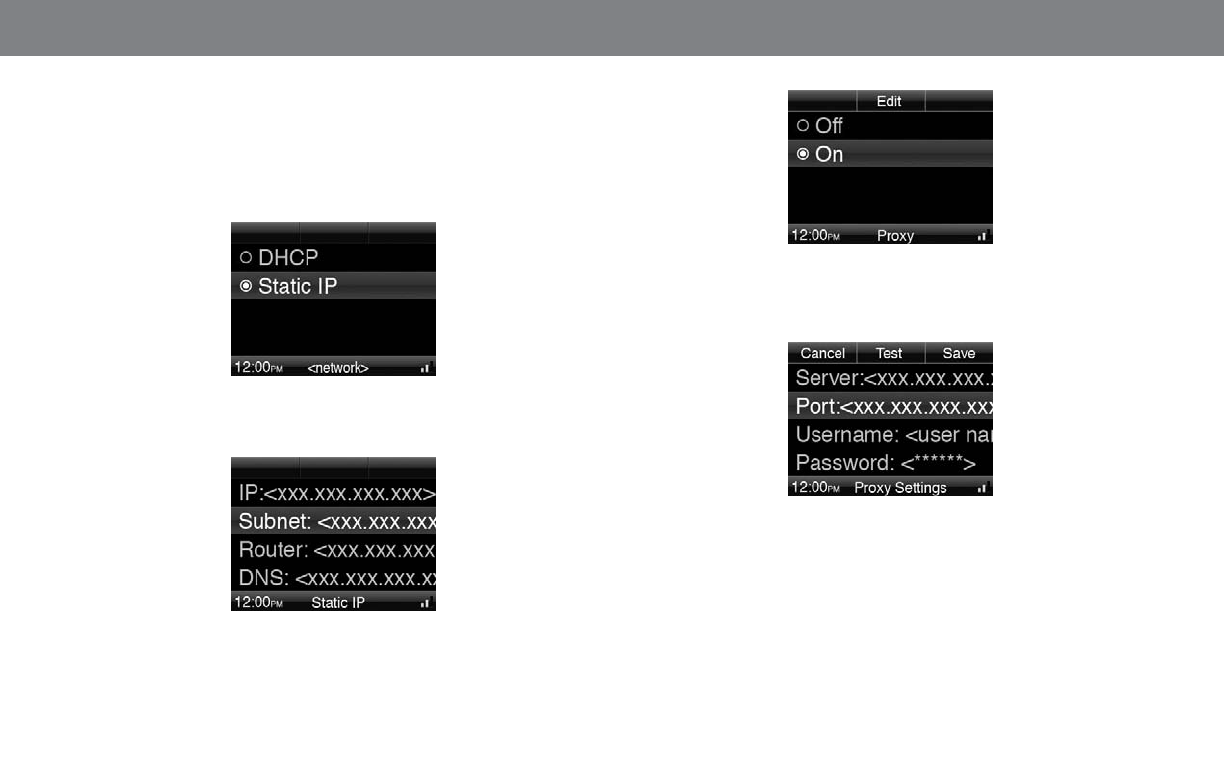
18
• Delete Connection: Select this option to delete a network from
the system. Deleting a network stops the JBL On Air Wireless from
automatically connecting to the network’s server and deletes all saved
information related to the network.
• IP Address Configuration: Select this to option configure the
network’s IP address. The IP Address screen will appear:
Select “DHCP” to configure the network from the server automatically.
Select “Static IP” to configure the network manually. The Static IP
screen will appear:
Select and manually enter the network’s IP, Subnet, Router and DNS
addresses. A data-entry screen will appear for each one. Select the
Right Soft (Save) button when you have finished entering each address.
• Proxy: Select this option to configure the network for a proxy server.
The Proxy screen will appear:
Select “Off” if the network does not have a proxy server. Select “On”
if the network does have a proxy server. Select the Center Soft (Edit)
button to enter the proxy server settings manually. The Proxy Settings
screen will appear:
Select and manually enter the proxy server’s server address and port
address, the proxy user name and the proxy password. A data-entry
screen will appear for each one. Select the Right Soft (Save) button
when you have finished entering each item.
When you have finished entering all the information, select the Center
Soft (Test) button to test the proxy settings. The JBL On Air Wireless will
attempt to connect to the proxy server using the settings you entered.
If it is successful, it will save the settings and display the previous menu
screen. If it is unsuccessful, it will display the error message returned by
the proxy server and you will need to correct the information you entered.

19www.jbl.com
English
speCifiCaTiOns
iPod/iPhone compatibility: Made for iPod nano 5th generation, iPod touch 2nd generation, iPod classic, iPod nano 4th generation,
iPod touch 1st generation, iPod nano 3rd generation, iPod with video
Made for iPhone 4, iPhone 3GS, iPhone 3G and iPhone
Not compatible with iPod/iPhone video and photo playback
The above information is correct as of the printing of this manual. Please check www.jbl.com for the latest
compatibility information.
Wi-Fi network compatibility: XXXX
Transducers: X x JBL XXXX transducers
Amplifier power: XX watts x 2
Frequency response: XXHz – XXkHz
Signal-to-noise ratio: >XXdB
Aux Input sensitivity/impedance: XXV/XX ohms
Input connections: Main connection – iPod and iPhone docking connector; Aux Input connection – 3.5mm (1/8") stereo mini jack
Power requirement: 12V DC
Power consumption: XXW (standby); XXW (maximum)
Dimensions (H x W x D): XX" x XX" x XX" (XXmm x XXmm x XXmm)
Weight: XX lb (XXkg)
Available finishes: XXXX
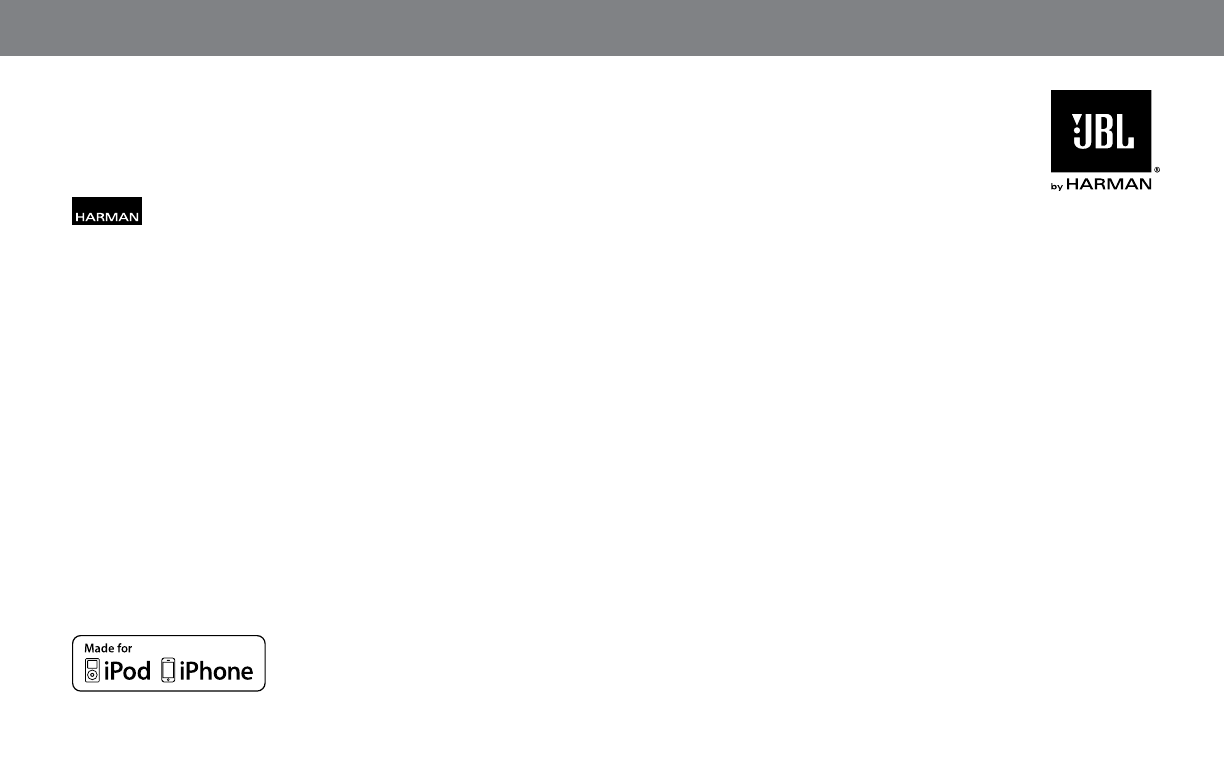
20
www.jbl.com
© 2010 HARMAN International Industries, Incorporated. All rights
reserved.
Features, specifications and appearance are subject to change without
notice.
JBL is a trademark of HARMAN International Industries, Incorporated,
registered in the United States and/or other countries.
Apple, iPhone, iPod, iPod nano, iPod classic, iTunes and iPod touch are
trademarks of Apple Inc., registered in the U.S. and other countries. iPod/
iPhone not included. “Made for iPod” and “Made for iPhone” mean that an
electronic accessory has been designed to connect specically to iPod and
iPhone, respectively, and has been certied by the developer to meet Apple
performance standards. Apple is not responsible for the operation of this
device or its compliance with safety and regulatory standards.
Wi-Fi is a registered trademark of the Wi-Fi Alliance. Wi-Fi Protected Setup
is a trademark of the Wi-Fi Alliance.
Part No.: 950-0309-001 Rev.: A
HARMAN Consumer, Inc.
8500 Balboa Boulevard, Northridge, CA 91329 USA
Federal Communication Commission Interference Statement
This equipment has been tested and found to comply with the limits for a Class B digital
device, pursuant to Part 15 of the FCC Rules. These limits are designed to provide
reasonable protection against harmful interference in a residential installation. This equipment
generates, uses and can radiate radio frequency energy and, if not installed and used in
accordance with the instructions, may cause harmful interference to radio communications.
However, there is no guarantee that interference will not occur in a particular installation. If
this equipment does cause harmful interference to radio or television reception, which can be
determined by turning the equipment off and on, the user is encouraged to try to correct the
interference by one or more of the following measures:
• Reorient or relocate the receiving antenna.
• Increase the separation between the equipment and receiver.
• Connect the equipment into an outlet on a circuit different from that to which the receiver
is connected.
• Consult the dealer or an experienced radio/TV technician for help.
FCC Caution: Any changes or modifications not expressly approved by the party responsible
for compliance could void the user's authority to operate this equipment.
This device complies with Part 15 of the FCC Rules. Operation is subject to the following two
conditions: (1) This device may not cause harmful interference, and (2) this device must
accept any interference received, including interference that may cause undesired operation.
FCC/IC Radiation Exposure Statement:
This equipment complies with FCC/IC RSS-102 radiation exposure limits set forth for an
uncontrolled environment. This equipment should be installed and operated with minimum
distance 20cm between the radiator & your body.
This Class [B] digital apparatus complies with Canadian ICES-003.
Cet appareil numérique de la classe [B] est conforme à la norme NMB-003 du Canada.